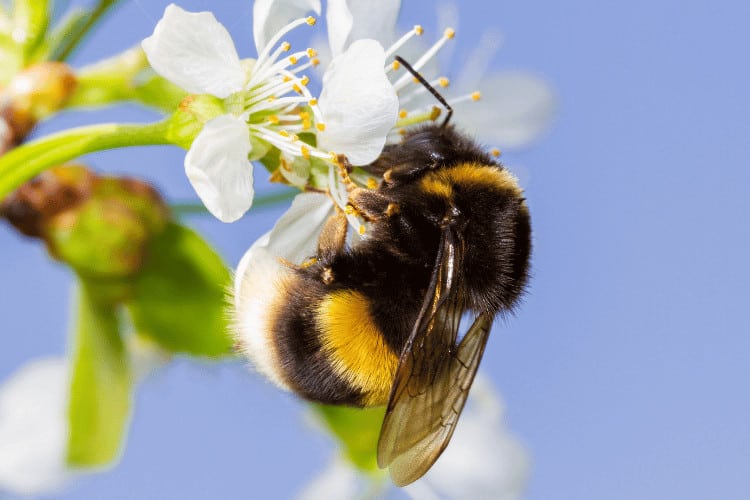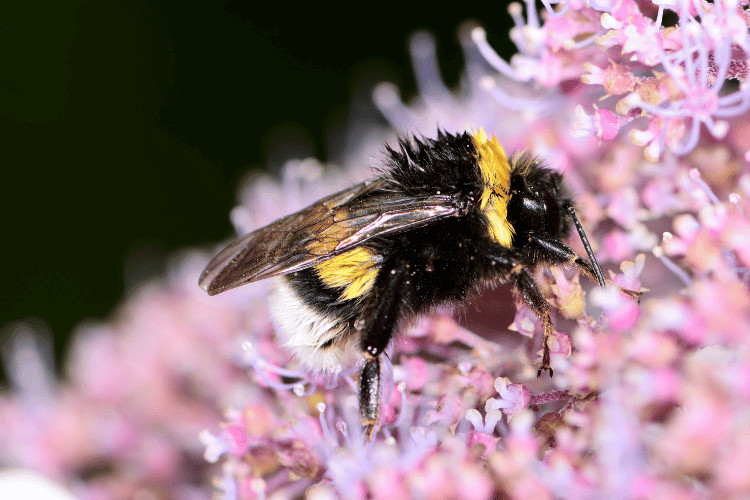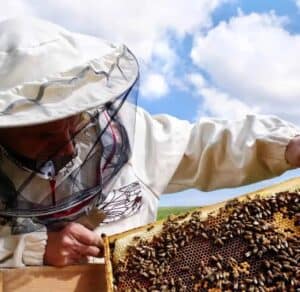Bumblebees: The Gentle Giants of the Bee World
As a beekeeper with multiple years of experience, I’ve worked with all sorts of bees, including honey bees, carpenter bees, and bumblebees. In today’s article, I’m going to talk to you about bumblebees.
Bumblebees are amazing creatures that play a vital role in our ecosystem. They’re important pollinators, and they help to ensure that our crops and wildflowers reproduce.
In this article, I’ll discuss the different types of bumblebees, what they look like, where they live, how they reproduce, what they eat, and how you can help to protect them.
So if you’re interested in learning more about these fascinating insects, read on!
What Are Bumblebees?

Bumblebees are large, fuzzy bees that are native to Europe, Asia, and North America. They have four wings and a long proboscis that they use to drink nectar from flowers.
What Do Bumblebees Look Like?
Bumblebees have a black and yellow striped body. They have a fuzzy coat of hair that helps to keep them warm. Bumblebees have large eyes and a long proboscis too.
Where Do Bumblebees Live?
Bumblebees can be found in a variety of habitats, including forests, meadows, and gardens.
They prefer to live in areas with plenty of flowers and nectar sources. Bumblebees can also be found in urban areas, as long as there are gardens and parks where they can find food and shelter.
How Do Bumblebees Reproduce?
In the spring, the queen bumblebee emerges from hibernation and starts a new colony. She lays eggs, and the worker bees hatch and help her to care for the young bees.
In the fall, the queen bumblebee mates with a drone, and she lays fertilized eggs that’ll become the next generation of queen bumblebees.
What Do Bumblebees Eat?
Bumblebees eat nectar and pollen from flowers.
They also eat honeydew, which is a sugary substance that’s produced by aphids and other insects. Bumblebees need nectar and pollen to get the energy to fly and care for their young.
Are Bumblebees Dangerous?
Bumblebees aren’t usually aggressive, but they’ll sting if they feel threatened. The bumblebee’s sting isn’t as painful as the sting of a honey bee, but it can still be dangerous for people who are allergic to bee stings.
What Are Examples of Bumblebees?
There’s around 250 different bumblebee species scattered all around the globe. They share a few characteristics and are unique in some. Let’s take a look at some of my favorite ones.
Common Eastern Bumblebee (Bombus pensylvanicus)
The eastern bumblebee is one of the most common species of bumblebee in North America. It’s a large, black and yellow bumblebee with a white tail. Bumble bees have fur all over their bodies, which helps them to collect pollen from flowers.
Additionally, the common eastern bumblebee can be found in a variety of habitats, including forests, meadows, and gardens. It’s an important pollinator of many different plants, such as tomatoes, blueberries, and cucumbers.
I’ve also found that it’s a social insect that lives in colonies of up to 500 individuals. The queen bee hibernates over the winter and emerges in the spring to start a new colony. Worker bees develop first, followed by males and new queens.
A fun fact my research found:
The common eastern bumble bee has been introduced in the western United States and overseas to help in crop pollination. The success of these programs is still being determined, as well as the harm that can be caused by releasing a non-native species.
Buff-Tailed Bumblebee (Bombus terrestris)
Did you know the buff-tailed bumblebee is one of the most common bumblebees in the UK?
It’s a large bumblebee with a yellow collar near the head and another on the abdomen. It’s typically found in lowland areas throughout the UK. It prefers grassland and open areas, but it can also be found in towns and gardens.
Just like their fellow bumblebees, buff-tailed bumblebees are excellent pollinators. They help to pollinate a wide variety of flowers, including daisies, clover, and honeysuckle.
Interestingly, I’ve found that buff-tailed bumblebees are nectar robbers too. This means that if they come across a flower that’s too deep for their tongue, they’ll bite a hole at the base of the flower and suck out the nectar.
Similar to the common bumblebee, the queen of the buff-tailed bumblebee hibernates over winter and starts a new colony in the spring. These bees emerge in early spring and their colonies can grow to up to 600 bees.
Meanwhile, the female workers collect nectar and pollen from flowers and bring it back to the nest to feed the young bees. The males don’t collect food, but they do mate with the queen bee.
Bombus Dahlbomii

The Bombus dahlbomii, also known as the Patagonian bumblebee or the Flying Mouse, is a large species of bumblebee that’s native to South America.
It’s actually the largest bumblebee species in the Southern Hemisphere! With queens that can grow up to 3 cm long. In my opinion, the Bombus dahlbomii is a striking insect, with a deep orange-ginger thorax and abdomen, and black legs and wings.
The Bombus dahlbomii is a social insect, meaning that it lives in colonies. A colony of Bombus dahlbomii can have up to 500 individuals. The queen bumblebee is the only female that reproduces.
I also learned that the Bombus dahlbomii is an important pollinator in its native range. It pollinates a variety of plants, including Chilean bellflower and Peruvian lily.
Sadly, the Bombus dahlbomii is now endangered due to habitat loss and the introduction of two non-native invasive European bumblebees, Bombus ruderatus and Bombus terrestris.
Honey Bees vs Bumblebees: A Comparison
We all know honey bees and bumblebees are two of the most common and important pollinators in the world—but there are some key differences between them.
From my experience, I’ve noticed the following distinctions between them so let’s take a closer look:
Appearance
Honey bees are smaller and slimmer than bumblebees.
They have a golden yellow body with brown bands, while bumblebees are larger and more robust, with a black and yellow striped body.
Honey bees also have less hair than bumblebees, making them easier to mistake for wasps.
Nesting Habits
Honey bees typically build their nests above ground in hollow trees or man-made hives.
Bumblebees, on the other hand, often nest underground in abandoned burrows or other cavities.
Social Interaction
Honey bees are highly social insects, living in colonies of up to 80,000 individuals.
Each colony has a queen bee, who lays the eggs, and female workers, who do all the other work, such as collecting food, building the hive, and caring for the young.
Bumblebees are also social insects, but their colonies are much smaller, with only a few hundred individuals.
Aggressiveness
Honey bees and bumblebees are generally docile insects, but they’ll sting if they feel threatened.
That said, honey bees are more likely to sting than bumblebees, as they have a barbed stinger that they cannot remove after they sting.
This means that they die after they sting, so they’re more reluctant to do so.
Honey Production
Honey bees are well-known for their honey production. They make large amounts of honey, which they store in the hive to eat during the winter.
Bumblebees, though, don’t produce honey in the same way that honey bees do. They make a small amount of honey, but it isn’t enough to sustain the colony through the winter.
Pollination

Both honey bees and bumblebees are important pollinators. They help to fertilize plants by transferring pollen from one flower to another.
Honey bees are more efficient pollinators than bumblebees, as they can travel further and faster.
However, bumblebees are better at pollinating deep flowers, as they have longer tongues and cupped hind legs for collecting pollen.
Winter Habits
Honey bees survive the winter by clustering together in their hive and generating heat.
Bumblebees, on the other hand, hibernate individually. They enter a state of dormancy and reduce their metabolism to conserve energy.
How to Take Care of Bumblebees
Bumblebees pollinate plants, which is essential for food production. Their numbers are declining everywhere, including Europe and North America.
We beekeepers can do a lot to help them continue to do their vital jobs effectively.
- Provide them with safe nesting sites. You can do this by building a bumblebee nest box or by leaving an old compost heap or birdhouse undisturbed.
- Plant plenty of flowers that bumblebees like. Bumblebees are attracted to flowers with deep nectaries, so try to plant flowers like hollyhocks, columbine, and lavender.
- Avoid using pesticides. Pesticides can kill bumblebees, so it’s best to avoid using them in your garden.
- Don’t be afraid of bumblebees. They’re generally docile insects and will only sting if they feel threatened. If you do get stung by a bumblebee, the pain should go away within a few hours. Apply a cold compress to the sting to help reduce the pain and swelling.
Wrap Up: Why Care for Bumblebees?
Bumblebees are amazing creatures that help to ensure that our crops and wildflowers reproduce. Bumblebees are also gentle giants, and they aren’t usually aggressive.
We can all do our part to help bumblebees by providing them with safe places to nest, planting flowers that they like, and avoiding using pesticides.
By taking these steps, we can help to ensure that bumblebees continue to thrive for generations to come.

Joseph Davis
My goal is to show that anyone can take up beekeeping and it can be a very rewarding hobby. I strive to share my experiences and answer any questions you may have.
